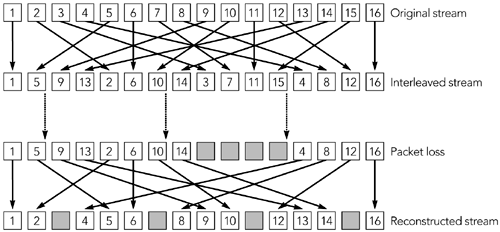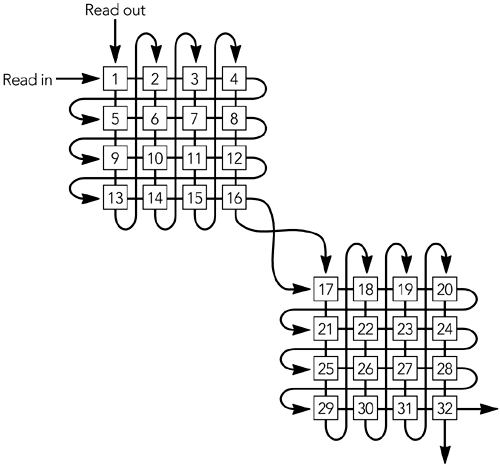Interleaving
| At the start of this chapter, it was noted that error concealment is something done by a receiver, without help from the sender. In general this is the case, but sometimes a sender can ease the task of error concealment without having to send extra information. One such example was noted for video, in which a sender can reduce the interframe dependency to ease the job of a receiver. A more general-purpose technique is interleaving, which can be used with both audio and video streams, as long as low delay is not a requirement. The interleaving process reorders data before transmission so that originally adjacent data is separated by a guaranteed distance during transport. Interleaving is useful because it makes bursts of consecutive packet loss in the transport stream appear as isolated losses when the original order is restored. In Figure 8.11, for example, the loss of four consecutive packets in the interleaved stream is transformed into four single-packet losses when the original order is reconstructed. The actual loss rate is unchanged, but it is typically easier for a receiver to conceal a series of single-packet losses than it is to conceal a longer burst of loss. Figure 8.11. Interleaving, Transforming Burst Loss to Isolated Loss (From C. Perkins, O. Hodson, and V. Hardman, "A Survey of Packet Loss Recovery Techniques for Streaming Media," IEEE Network Magazine, September/October 1998. 1998 IEEE.) The simplest implementation of an interleaving function is with a pair of matrices, as shown in Figure 8.12. Frames of media data are read into the first matrix by rows until that matrix is full. At that time the two matrices are switched, with data being read out of the first by columns , as the second is filled by rows. The process continues, with frames being read into one matrix as they are read out of the other. Figure 8.12. An Interleaving Matrix Both sender and receiver must maintain buffer matrices as arrays of an appropriate size. The sender takes the output by columns and inserts it into packets for transport. The receiver takes the packets from the transport stream and passes them into the matrix buffer by rows, and as they are read out by columns the original order is restored. Interleaving may be done at the RTP packet level, but more often multiple frames within each packet are interleaved. When interleaving is done at the RTP packet level, the codec data is packed into RTP packets as usual. The interleaving operates on complete packets, resulting in a series of packets that have nonconsecutive RTP timestamps. The RTP sequence number should be generated after interleaving, resulting in packets that have consecutive sequence numbers as sent. When interleaving is done with multiple frames within each packet, the RTP timestamp and sequence number are unchanged from the noninterleaved format. Putting multiple codec frames into each RTP packet so that each column of the interleaver forms an RTP packet keeps these values constant. The interleaving function should be chosen so that adjacent packets in the original stream are separated by more than the maximum consecutive loss length in the transport stream. A matrix-based implementation with n rows of m columns will produce output with originally adjacent symbols separated by n others. Put another way, as m or fewer packets are lost during transport of each matrix, each group of n packets after deinterleaving will have at most one loss. The transport process must communicate the size of the interleaving group ”the dimensions of the matrix ”and the position of each packet within that group. The size of the interleaving group may be fixed and communicated out of band , or it may be included within each packet, allowing the interleaving function to vary. The position of each packet within an interleaving group must be included with the packet if the group size can vary, or it may be inferred from the RTP sequence number if the group size is fixed. A good example of the use of interleaving is the loss-tolerant payload format for MPEG Audio Layer-3 (MP3), 38 which was developed in response to the lack of resilience of the original payload format 12 to packet loss. Other examples of interleaving may be found in the payload formats for AMR (Adaptive Multi-Rate) and AMR-WB (Adaptive Multi-Rate Wideband) audio. 41 There is no single standard for interleaving; each payload format must implement it individually. Interleaving adds considerable latency to the transmission process. 97 The same number of packets as in the interleave group at both sender and receiver will be buffered. For example, if a 5 x 3 matrix implementation is used, 15 packets will be buffered at the sender, and 15 at the receiver, in addition to the network delay. This makes interleaving unsuitable for interactive applications; however, interleaving works well for streaming. |
EAN: 2147483647
Pages: 108

